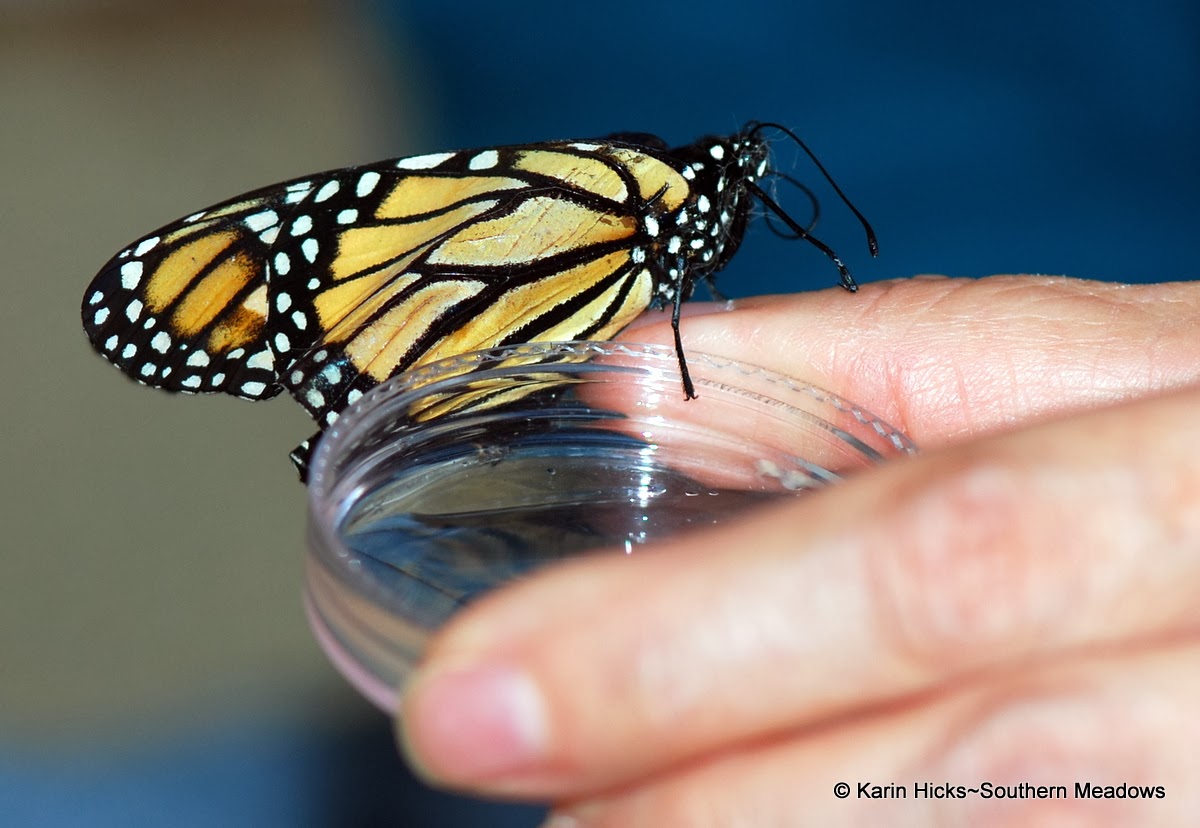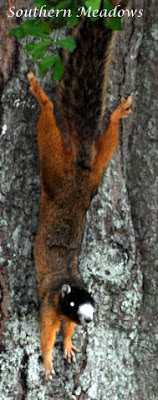A Special Monarch Butterfly
Butterflies are intriguing insects and we support many species of butterflies in our garden by providing host and nectar plants. This past year we saw record numbers of certain species such as the Variegated and Gulf Fritillaries but very low numbers in others such as the Monarch where we only spotted one all season. Just a few miles down the road my friend, Penny had lots of Monarchs in her garden. What a difference a few miles can make!
Penny spent a lot of time studying the Monarchs in her garden. She watched the monarchs lay eggs, caterpillars grow from one instar to the next but when they crawled off to form their chrysalis she never could find them. Since she wanted to observe the entire life cycle she decided to grab a few fat caterpillars when she saw them crawling away from the milkweed and put them in her habitat cage. She was then able to watch up close how it formed its chrysalis and also see it eclose from the chrysalis 8 to 12 days later. The following two photos are hers that she took of the monarch in action.
When a butterfly reaches maturity it emerges from the chrysalis and uses
its legs to pull itself out and cling to the empty shell so that its
crumpled wings can hang down. It pumps its wings slowly up and down to force fluid (hemolymph) into
the wings. The butterfly then stretches its wings out to dry. The
butterfly has about an hour to do this otherwise the wings will dry in
their folded position and will be permanently deformed.
Have you ever found a butterfly with deformed wings in your garden? There are several reasons this can occur. It could be that the butterfly falls to the ground while its wings are wet and they become damaged. Sometimes butterflies don't have enough room to fully spread their wings during this critical time or the butterfly may have a defect which prevents the wings from opening properly. Crinkled wings is one of the signs of O.E. (Ophryocystis elektroscirrha), a protozoan parasite that infects Monarchs all over the world. I wrote a post about this last year, O.E. and Monarch Conservation. You can read it here.
What would you do if you found a butterfly that had deformed wings? Well, my friend, Penny found a special Monarch in her garden and being the kind soul that she is she brought him inside. She knew that he wouldn't survive on his own. Without the ability to fly properly, and since it was early December and the temperatures were dropping, his hours were numbered.
The day I visited, he ate heartily. Notice his feet resting in the liquid in the photo above...butterflies have sensory organs on their feet and this would indicate to him that this honey solution was something tasty to eat. In the photo below you can see his proboscis is unfurled and he is drinking.
Penny kept him in a temperature controlled patio where he could rest comfortably. He would flap his wings to get around and crawl on the floor. He had a favorite corner he would go to and let the sun shine down on him through the floor to ceiling windows. Penny's pet monarch lived for a good 6 weeks but then his time had come. Thanks to Penny's tender heart and devotion he had a great life considering his circumstances. In addition it was an enthralling learning experience and I am so glad that she was able to share it with me.
Penny spent a lot of time studying the Monarchs in her garden. She watched the monarchs lay eggs, caterpillars grow from one instar to the next but when they crawled off to form their chrysalis she never could find them. Since she wanted to observe the entire life cycle she decided to grab a few fat caterpillars when she saw them crawling away from the milkweed and put them in her habitat cage. She was then able to watch up close how it formed its chrysalis and also see it eclose from the chrysalis 8 to 12 days later. The following two photos are hers that she took of the monarch in action.
 |
| ©Penny Stowe |
 |
| ©Penny Stowe |
Have you ever found a butterfly with deformed wings in your garden? There are several reasons this can occur. It could be that the butterfly falls to the ground while its wings are wet and they become damaged. Sometimes butterflies don't have enough room to fully spread their wings during this critical time or the butterfly may have a defect which prevents the wings from opening properly. Crinkled wings is one of the signs of O.E. (Ophryocystis elektroscirrha), a protozoan parasite that infects Monarchs all over the world. I wrote a post about this last year, O.E. and Monarch Conservation. You can read it here.
What would you do if you found a butterfly that had deformed wings? Well, my friend, Penny found a special Monarch in her garden and being the kind soul that she is she brought him inside. She knew that he wouldn't survive on his own. Without the ability to fly properly, and since it was early December and the temperatures were dropping, his hours were numbered.
She feed him diluted honey water from a petri dish. Sometimes she used a paperclip to unfurl his proboscis to help the drinking process along.
Penny kept him in a temperature controlled patio where he could rest comfortably. He would flap his wings to get around and crawl on the floor. He had a favorite corner he would go to and let the sun shine down on him through the floor to ceiling windows. Penny's pet monarch lived for a good 6 weeks but then his time had come. Thanks to Penny's tender heart and devotion he had a great life considering his circumstances. In addition it was an enthralling learning experience and I am so glad that she was able to share it with me.





.png)
